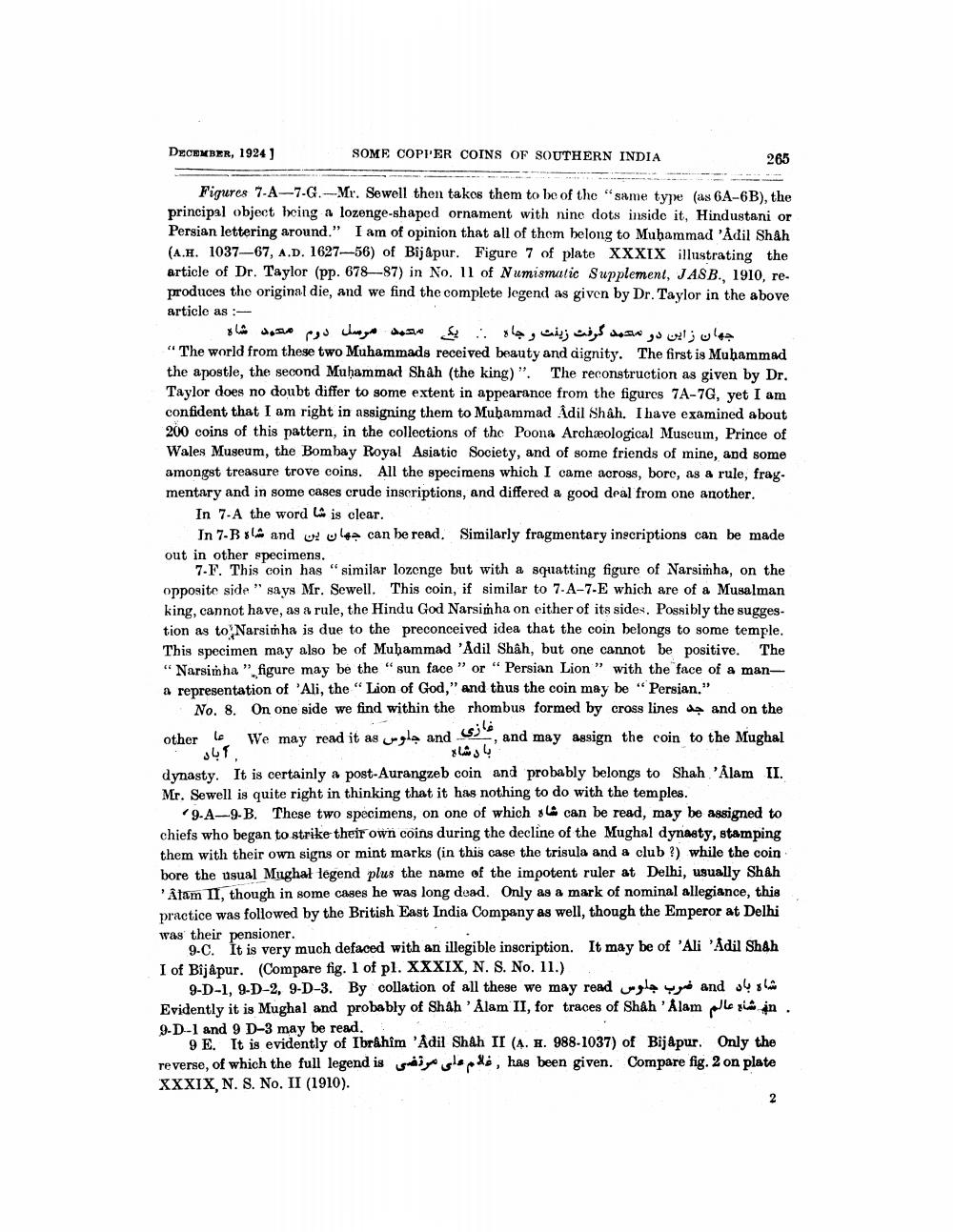________________
DECEMBER, 1924]
SOME COPPER COINS OF SOUTHERN INDIA
Figures 7-A-7-G.-Mr. Sewell then takes them to be of the "same type (as 6A-6B), the principal object being a lozenge-shaped ornament with nine dots inside it, Hindustani or Persian lettering around." I am of opinion that all of them belong to Muhammad 'Adil Shah (A.H. 1037-67, A.D. 1627-56) of Bijapur. Figure 7 of plate XXXIX illustrating the article of Dr. Taylor (pp. 678-87) in No. 11 of Numismatic Supplement, JASB., 1910, reproduces the original die, and we find the complete legend as given by Dr. Taylor in the above
article as:
جهان زاین در محمد گرفت زینت و جاه .. یکے محمد مرسل دوم محمد شاه
"The world from these two Muhammads received beauty and dignity. The first is Muhammad the apostle, the second Muḥammad Shah (the king)". The reconstruction as given by Dr. Taylor does no doubt differ to some extent in appearance from the figures 7A-7G, yet I am confident that I am right in assigning them to Muhammad Adil Shah. I have examined about 200 coins of this pattern, in the collections of the Poona Archæological Museum, Prince of Wales Museum, the Bombay Royal Asiatic Society, and of some friends of mine, and some amongst treasure trove coins. All the specimens which I came across, bore, as a rule, fragmentary and in some cases crude inscriptions, and differed a good deal from one another.
In 7-A the word is clear.
عا other , آباد
265
In 7-B s and out in other specimens.
7-F. This coin has "similar lozenge but with a squatting figure of Narsimha, on the opposite side" says Mr. Sewell. This coin, if similar to 7-A-7-E which are of a Musalman king, cannot have, as a rule, the Hindu God Narsimha on either of its sides. Possibly the suggestion as to Narsimha is due to the preconceived idea that the coin belongs to some temple. This specimen may also be of Muhammad 'Adil Shâh, but one cannot be positive. The "Narsimha "figure may be the "sun face" or "Persian Lion" with the face of a mana representation of 'Ali, the "Lion of God," and thus the coin may be "Persian."
No. 8. On one side we find within the rhombus formed by cross lines and on the
and
and may assign the coin to the Mughal
le can be read. Similarly fragmentary inscriptions can be made
We may read it as
فازی با دشاہ
dynasty. It is certainly a post-Aurangzeb coin and probably belongs to Shah 'Alam II. Mr. Sewell is quite right in thinking that it has nothing to do with the temples.
9-A-9-B. These two specimens, on one of which can be read, may be assigned to chiefs who began to strike their own coins during the decline of the Mughal dynasty, stamping them with their own signs or mint marks (in this case the trisula and a club?) while the coin bore the usual Mughal legend plus the name of the impotent ruler at Delhi, usually Shah 'Atam II, though in some cases he was long dead. Only as a mark of nominal allegiance, this practice was followed by the British East India Company as well, though the Emperor at Delhi was their pensioner.
It may be of 'Ali 'Adil Shah
9-C. It is very much defaced with an illegible inscription. I of Bijapur. (Compare fig. 1 of pl. XXXIX, N. S. No. 11.)
and
9-D-1, 9-D-2, 9-D-3. By collation of all these we may read Evidently it is Mughal and probably of Shah Alam II, for traces of Shah Alam 9-D-1 and 9 D-3 may be read.
lesin.
9 E. It is evidently of Ibrâhîm 'Adil Shah II (A. H. 988-1037) of Bijapur. Only the reverse, of which the full legend is, has been given. Compare fig. 2 on plate XXXIX, N. S. No. II (1910).
2




